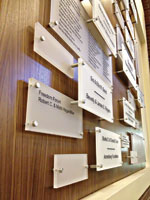Standoffs are round, metallic, puck-topped little barrels that hold flat acrylic and metal sign panels and plaques in many exterior and interior locations.
They are used to attach these types of signs to a wall with a minimum of four small cylinders of a specific length—one in each corner. They are mounted slightly off the finish or surface, hence, making the sign “stand off” from the wall.
We tend to readily design with standoffs in mind or, rather, with the round, finial, metallic puck that is the topper of the standoff as a visually acceptable fastener—even while the actual, unacceptable fastener hides just below
the surface.
These components are usually made of metal (although that is not always the case, as you will learn later on) and are defined in size because sign makers typically purchase them from a catalog as opposed to fabricating them specifically for a job.
However there may arise times for in-shop fabrication of standoffs.
For example, when you find yourself needing a non-stock length of standoff, you should consider cutting a metal tube to length and then painting it with an internal sleeve. Internally a short section of appropriately sized hose will center the outside nicely around a threaded rod going through (visualize an automotive vacuum line or water hose here).
This reasoning may even account for the use of faux pucks to simulate a real standoff. What looks like a standoff could actually be a length of painted tube with a button at the end featuring a counter sunk 1/4-20 threaded insert in between.
Creating your own puck for the finish is also a convenient way to match materials in the design. It also hides the real fastener for a bit of pilfer proofing.
Installation
The logic behind standoffs is simple. They are used when you need a way to not only mount a sign but also make it look elegant and easy to do. The hardware needs to be invisible while still in plain sight.
Fortunately mounting a typical four-standoff sign is a straightforward process—four sides and four mounts symmetrically from the perimeter corner points. (Note: the location of the round dot being inset symmetrically from the perimeter corner points).
Yet this mounting of a four-standoff sign is also one that boasts a variety of different options.
If you are installing standoffs on just one sign, use the sign itself to mark the wall for drilling.
However, if you are going to be using them for many signs, then make a template to mark the holes.
Templates are especially useful when the standoff-mounted panels are going to be positioned in a defined, repeating location (a hospital or a hotel spring immediately to mind).
A reusable template for standoffs is actually very simple to make. This falls under my professional motto: “Work smarter, not harder.” In fact, you can simply CNC router-cut a template out of thin hardboard.
Some adjustability may be desired here though.
It is easier, for example, to place a drill guide against the doorframe and flat to the floor for an efficient way to mark the holes.
Standoff fasteners are varied in both the connection to the wall and the holding of the sign.
If they are going to be used for holding a sign, the standoffs involved might have need for additional washers, cushions, or spacers. (Note: This added price may not be needed for a simple sign panel.)
Standoffs are a popular component that is utilized to firmly hold glass tenant identifiers. However keep in mind that a white backer, which can often be made from vinyl, appears to be a requirement here for readability purposes, as black letters on glass panels will cast a slight shadow and the clear of the glass on metal can be an oddly reflecting combination.
Multi-part standoffs, i.e., those with the removable threaded inserts, are often a plus in sign installation based on their adjustability.
Let me explain: The first insert is mounted to the wall. The barrel then goes on with the second insert and with the stud sticking out. (Note: Keep the barrels loose until the panel is over all the studs and the pucks are threaded on partway.
After checking to make sure that they are level, finish tightening one or two of the standoffs and then adjust the balance to keep the sign in place.
If there is an additional adjustment required, the fastener on the first insert has a chance at adjustment here. The barrel may even end up with a slight angle to make the sign hold.
This style of standoff also allows for alternate fasteners into the wall. Wood screws are typical, but machine bolts are a plus when the facility construction is going to be unpredictable.
Bigger signs equate to either the need for bigger standoffs and/or more mounts. And more mounts equate to a greater chance of error.
One thought here: Make the mounting holes in these bigger signs a bit larger (and not just bigger than the diameter of that finishing puck).
Also use fasteners, where possible, that float in the wall. Now I agree that this is not always possible, but the traditional toggle fastener has adjustability in the nature of the method. For example, the hole, sufficient in size for the fastener to get into the wall, is much larger than the component being threaded into it.
An interesting trick is the barrel of the standoff being hollow and not threaded. It simply acts as the spacer behind the sign panel.
The threaded stud or hanger bolt goes into the wall by itself. Adjustments are made with a pair of lineman pliers or a hammer. A tweak here and a bump there result in an easy way to level the sign out, if needed.
S tandoff Sights
tandoff Sights
Standoff supports are a great way to mount a sign to an uneven surface. They keep the sign panel away from the wall while still looking to the viewer as if it was always planned as flat.
The distance from the background also allows for additional thickness to the graphic or fasteners that may protrude unseen out the back of the sign.
If the object is to enhance the dimensionality of the sign, multiple standoffs can be utilized with several flat, layered shapes. The result is faux-3D signage!
Just connect individual standoff barrels with threaded studs. Only one final cap is needed.
(Note: One long stud could do the trick, if the assembly is in a controlled environment without the assembly obstruction that gravity often plays.)
Standoff fasteners are a clean way to have a changeable panel on a sign. These are easy for tenant panels that, in the long run, will be swapped out.
But if standoffs are going to be used for changeability, someone out there may tempt fate and see how easy it is to take them off.
Fortunately methods exist out there to make the hardware a little more tamper-resistant.
Secondary set screws are one way to lock the standoff onto the internal stud. After all, the idea that a passerby has a 2mm hex key on their person is a remote assumption.
So a screw set in the puck or barrel holds the standoff assembled as desired. This feature also allows for the puck finish to remain slightly loose for expansion or imperfections in the mounting surface.
Maybe you have seen standoffs where there is a small hole in the side. If so, place a nail or drill bit in and it turns tighter than hand-tight and easier than a tool.
Several companies also make standoffs with decorative hole patterns in the face, which are intended to be used with a special spanner tool uncommon to the general public that fits correctly into those little holes.
On the reverse side, in the right location and if the panels are light enough, you may only need two fasteners into the wall at the top.
The bottom two look good, but in all honesty, they are really just along for the ride.
By Peter Perszyk
Photos (top to bottom): Peter Perszyk, Dave Forrest, Gyford.











